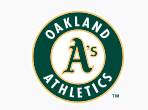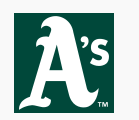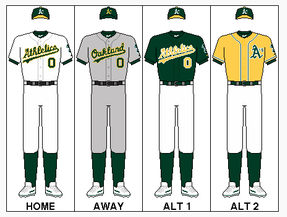
The Oakland Athletics are a Major League Baseball team based in Oakland, California. The Athletics are a member of the Western Division of Major League Baseball's American League. From 1968 to the present, the Athletics have played in the Oakland Coliseum.
The "Athletics" name originates from the late 19th century "athletic clubs", specifically the Philadelphia Athletics baseball club. They are most prominently nicknamed "the A's", in reference to the Gothic script "A", a trademark of the team and the old Athletics of Philadelphia. This has gained very prominent use, and in some circles is used more frequently than the full "Athletics" name. They are also known as "the White Elephants" or simply "the Elephants", in reference to then New York Giants' manager John McGraw's calling the team a "white elephant".[1] This was embraced by the team, who then made a white elephant the team's mascot, and often incorporated it into the logo or sleeve patches. During the team's 1970s heyday, management often referred to the team as The Swingin' A's, referencing both their prodigious power and to connect the team with the growing disco culture.
One of the American League's eight charter franchises, the club was founded in Philadelphia, Pennsylvania, in 1901 as the Philadelphia Athletics. The team had some prominent success in Philadelphia, winning three of four World Series from 1910 to 1913 and two in a row in 1929 and 1930. The team's owner and manager for its first 50 years was Connie Mack, and its Hall-of-Fame players included Chief Bender, Frank "Home Run" Baker, Jimmie Foxx and Lefty Grove. After two decades of decline, however, the team left Philadelphia for Kansas City in 1955 and became theKansas City Athletics.
After 13 mostly uneventful seasons in the Midwest, the team moved to Oakland in 1968. There a dynasty soon emerged, with three World Championships in a row from 1972 to 1974 led by players including Catfish Hunter, Reggie Jackson, ace reliever Rollie Fingers, and colorful owner Charlie O. Finley. After being sold by Finley to Walter A. Haas, Jr., the team eventually won three consecutive pennants and the 1989 World Series behind Rickey Henderson, Mark McGwire, and Dennis Eckersley. In more recent years, the A's have often been playoff contenders but have not returned to the World Series since 1990. In 2002, the A's won 20 games in a row, which broke an AL record, as shown in the film Moneyball.
Origins
Origin of the team name
The Athletics' name originated in the term "Athletic Club" for local gentlemen's clubs—dates to 1860 when an amateur team, the Athletic (Club) of Philadelphia, was formed. (A famous image from that era, published in Harper's Weekly in 1866, shows the Athletic players dressed in uniforms displaying the familiar blackletter "A" on the front). The team later turned professional through 1875, becoming a charter member of the National League in 1876, but were expelled from the N.L. after one season. A later version of the Athletics played in the American Associationfrom 1882–1891.
Uniform emblem
Through the seasons, the Athletics' uniforms have usually paid homage to their amateur forebears to some extent. Until 1954, when the uniforms had "Athletics" spelled out in script across the front, the team's name never appeared on either home or road uniforms. Furthermore, neither "Philadelphia" nor the letter "P" ever appeared on the uniform or cap. The typical Philadelphia uniform had only a script "A" on the left front, and likewise the cap usually had the same "A" on it. In the early days of the American League, the standings listed the club as "Athletic" rather than "Philadelphia", in keeping with the old tradition. Eventually, the city name came to be used for the team, as with the other major league clubs.
After buying the team in 1960, owner Charles O. Finley introduced new road uniforms with "Kansas City" printed on them, as well as an interlocking "KC" on the cap. Upon moving to Oakland, the "A" cap emblem was restored, although in 1970 an "apostrophe-s" was added to the cap and uniform emblem to reflect the fact that Finley was in the process of officially changing the team's name to the "A's."
Also while in Kansas City, Finley changed the team's colors from their traditional red, white and blue to what he termed "Kelly Green, Wedding Gown White and Fort Knox Gold." It was also here that he began experimenting with dramatic uniforms to match these bright colors, such as gold sleeveless tops with green undershirts and gold pants. The innovative uniforms only increased after the team's move to Oakland, which also came at the time of the introduction of polyester pullover uniforms. During their dynasty years in the 1970s, the A's had dozens of uniform combinations with jerseys and pants in all three team colors, and in fact did not wear the traditional gray on the road, instead wearing green or gold, which helped to contribute to their nickname of "The Swingin' A's." After the team's sale to the Haas family, the team changed its primary color to a more subdued forest green and began a move back to more traditional uniforms.
Currently, the team wears home uniforms with "Athletics" spelled out in script writing and road uniforms with "Oakland" spelled out in script writing, with the cap logo consisting of the traditional "A" with "apostrophe-s." The home cap is green with a gold bill and white lettering, while the road cap, debuting in 1994, is all green with gold lettering. Regardless of road or home games, the batting helmets used are green with gold brim.
Since 1994, the A's have worn green alternates jerseys with the word "Athletics" in gold. It is used on both road and home games. During the 2000s, the Athletics introduced black as one of their colors. They began wearing a black alternate jersey with "Athletics" written in green. After a brief discontinuance, the A's brought back the black jersey, this time with "Athletics" written in white with gold highlights. Commercially popular but rarely chosen as the alternate by players, in 2011 they were replaced by a new gold alternate jersey with "A's" in green on the left chest, which they also wear either at home or on the road.
The nickname "A's" has long been used interchangeably with "Athletics," dating to the team's early days when headline writers wanted a way to shorten the name. From 1972 through 1980, the team nickname was officially "Oakland A's," although, during that time, the Commissioner's Trophy, given out annually to the winner of baseball's World Series, still listed the team's name as the "Oakland Athletics" on the gold-plated pennant representing the Oakland franchise. According to Bill Libby's Book, Charlie O and the Angry A's, owner Charlie O. Finley banned the word "Athletics" from the club's name because he felt that name was too closely associated with former Philadelphia Athletics owner Connie Mack, and he wanted the name "Oakland A's" to become just as closely associated with him. The name also vaguely suggested the name of the old minor league Oakland Oaks, which were alternatively called the "Acorns." New owner Walter Haas restored the official name to "Athletics" in 1981, but retained the nickname "A's" for marketing purposes. At first, the word "Athletics" was restored only to the club's logo, underneath the much larger stylized-"A" that had come to represent the team since the early days. By 1987, however, the word returned, in script lettering, to the front of the team's jerseys.
The A's are the only MLB team to wear white cleats, both at home and on the road, another tradition dating back to the Finley ownership.
Elephant mascot
After New York Giants manager John McGraw told reporters that Philadelphia manufacturer Benjamin Shibe, who owned the controlling interest in the new team, had a "white elephant on his hands," Mack defiantly adopted the white elephant as the team mascot, and presented McGraw with a stuffed toy elephant at the start of the 1905 World Series. McGraw and Mack had known each other for years, and McGraw accepted it graciously. By 1909, the A's were wearing an elephant logo on their sweaters, and in 1918 it turned up on the regular uniform jersey for the first time. Over the years the elephant has appeared in several different colors. It is currently forest green.
The elephant was replaced as the team mascot in 1963 by then-owner Charles O. Finley in favor of a Missouri mule (it was also rumored to have been done by Finley in order to attract fans from the then heavily Democratic constituents of Missouri by replacing the traditional Republican mascot to one associated with Democrats). In 1988, the elephant was restored as the symbol of the Athletics and currently adorns the left sleeve of home and road uniforms. The elephant mascot returned briefly in the mid-'80s, under the name Harry Elephante. In 1997, the elephant returned, taking its current form, Stomper.
Franchise history
Main articles: History of the Philadelphia Athletics and History of the Oakland Athletics
The history of the Athletics Major League Baseball franchise spans the period from 1901 to the present day, having begun in Philadelphia before moving to Kansas City in 1955 and then to its current home in Oakland, California in 1968.
Stadium
The O.co Coliseum—originally known as the Oakland-Alameda County Coliseum, and later named as Network Associates, McAfee and Overstock.com Coliseum—was built as a multi-purpose facility. Louisiana Superdome officials pursued negotiations with Athletics officials during the 1978–1979 baseball off-season about moving the Athletics to the Superdome in New Orleans. The Athletics were unable to break their lease at the Coliseum, and remained in Oakland.[2]
After the Oakland Raiders football team moved to Los Angeles in 1982, many improvements were made to what was suddenly a baseball-only facility. The 1994 movie Angels in the Outfield was filmed in part at the Coliseum, filling in forAnaheim Stadium.
Then, in 1995, a deal was struck whereby the Raiders would move back to Oakland for the 1995 season. The agreement called for the expansion of the Coliseum to 63,026 seats. The bucolic view of the Oakland foothills that baseball spectators enjoyed was replaced with a jarring view of an outfield grandstand contemptuously referred to as "Mount Davis" after Raiders' owner Al Davis. Because construction was not finished by the start of the 1996 season, the Athletics were forced to play their first six-game homestand at 9,300-seat Cashman Field in Las Vegas.[3]
Although official capacity was stated to be 43,662 for baseball, seats were sometimes sold in Mount Davis as well, pushing "real" capacity to the area of 60,000. The ready availability of tickets on game day made season tickets a tough sell, while crowds as high as 30,000 often seemed sparse in such a venue. On December 21, 2005, the Athletics announced that seats in the Coliseum's third deck would not be sold for the 2006 season, but would instead be covered with a tarp, and that tickets would no longer be sold in Mount Davis under any circumstances. That effectively reduced capacity to 34,077, making the Coliseum the smallest stadium in Major League Baseball. As of 2008, sections 316–318 are the only open third-deck sections for A's games, bringing the total capacity to 35,067.
The Athletics are the only remaining MLB team in the United States still sharing a stadium with an NFL team. In Canada, Toronto's Rogers Centre is shared by the Blue Jays and the Canadian Football League's Toronto Argonauts, and is also used by the Buffalo Bills on occasion.
In 2011, the Athletics had the lowest attendance in baseball, with an average attendance of 18,232. [4]
New stadium proposals
Main article: Cisco Field
Since the mid-2000s the A's have been in talks with Oakland and other Northern California cities about building a new baseball-only stadium. One planned stadium, Cisco Field, was originally intended to be built in Fremont, California (a location that has since been abandoned). There were talks about it remaining in Oakland and there are currently talks about building it in San Jose.
Additionally there have been some proposals about moving the team to Sacramento and renovating that city's Minor League stadium.
Fremont
After the city of Oakland failed to make any progress toward a stadium, the A's began contemplating a move to the Warm Springs district of suburban Fremont. Fremont is about 25 miles south of Oakland; many nearby residents are already a part of the current Athletics fanbase.
On November 7, 2006, many media sources announced the Athletics would be leaving Oakland as early as 2010 for a new stadium in Fremont, confirmed the next day by the Fremont City Council. The plan was strongly supported by Fremont MayorBob Wasserman.[5] The team would have played in what was planned to be called Cisco Field, a 32,000-seat, baseball-only facility.[6] The proposed ballpark would have been part of a larger "ballpark village" which would have included retail and residential development. On February 24, 2009, however, Lew Wolff released an open letter regarding the end of his efforts to relocate the A's to Fremont.[7]
Sacramento
If negotiations within the Bay Area fail, Sacramento is considered a possible destination for the team.[8] Sacramento is the home of the team's AAA affiliate, the River Cats. The River Cats' stadium, Raley Field, would need significant construction to increase seating capacity to accommodate a major league team, but would probably not need to be demolished.[9]
San Jose
As of February 26, 2009 the city of San Jose was expected to open negotiations with the team. Although parcels of land south of Diridon Station are being acquired by the city as a stadium site, the San Francisco Giants' claim on Santa Clara County as part of their home territory would have to be dealt with before any agreement could be made.[10]
By August 2010, San Jose was "aggressively wooing" A's owner Lew Wolff. Wolff referred to San Jose as the team's "best option", but Major League Baseball Commissioner Bud Selig said he would wait on a report on whether the team could move to the area because of the Giants conflict.[11]
In September 2010, 75 Silicon Valley CEOs drafted and signed a letter to Bud Selig urging a timely approval of the move to San Jose.[12]
In May 2011 San Jose Mayor Chuck Reed sent a letter to Bud Selig asking the commissioner for a timetable of when he might decide whether the A's can pursue this new ballpark, but Selig did not respond.[13]
Selig addressed the San Jose issue via an online town hall forum held in July 2011, saying, "Well, the latest is, I have a small committee who has really assessed that whole situation, Oakland, San Francisco, and it is complex. You talk about complex situations; they have done a terrific job. I know there are some people who think it's taken too long and I understand that. I'm willing to accept that. But you make decisions like this; I've always said, you'd better be careful. Better to get it done right than to get it done fast. But we'll make a decision that's based on logic and reason at the proper time."[14]
Rivals
San Francisco Giants
See also: Bay Bridge Series
The Bay Bridge Series is the name of a series games played between (and the rivalry of) the A's and San Francisco Giants of the National League. The series takes its name from the San Francisco – Oakland Bay Bridge which links the cities of Oakland and San Francisco. Although competitive, the regional rivalry between the A's and Giants is considered a friendly one with mostly mutual companionship between the fans, as opposed to White Sox–Cubs, or Yankees–Mets games where animosity runs high. Hats displaying both teams on the cap are sold from vendors at the games, and once in a while the teams both dress in uniforms from a historic era of their franchises.






















